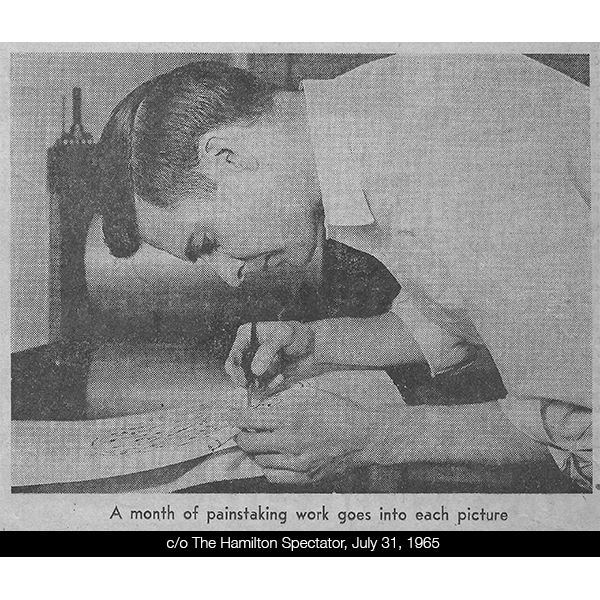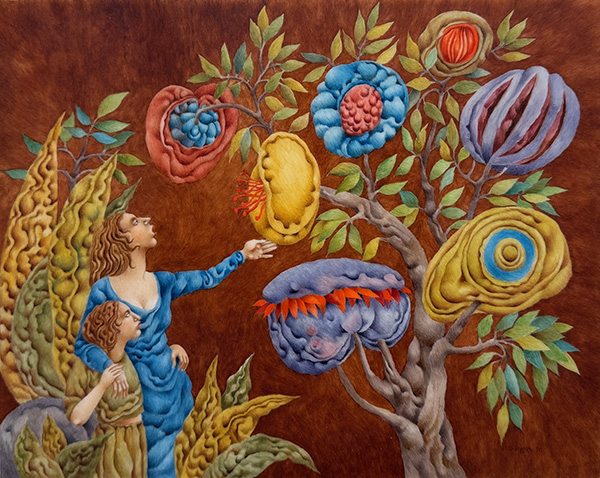Gary Slipper
(1934-2019) - Artist Biography by Mina Ivosev
Gary Slipper was born in Calgary, Alberta. His father was Stanley Edes Slipper, a surveyor and geologist who discovered several gas fields in the Peace River area. As a child, Gary thought he would either become a geologist like his father or an artist. Slipper showed early artistic promise, beginning to paint at the age of 9. By 11 years old, Slipper had enrolled in night classes and was studying at a number of arts institutions both domestic and abroad, including the Allied Arts Centre in Banff, the Banff School of Fine Arts, the Vancouver School of Art, and the American Academy of Art in Chicago. Slipper quit school at the age of 15 to focus on his art; “Painting came hard for me,” Slipper said of his work (Hamilton Spectator, 1965). Slipper later continued his education in Italy and Spain, where he studied at the Real Academia de Bellas Artes in San Fernando, Madrid in 1953.
The Globe and Mail, Sept. 3, 1976
Slipper’s travels in Spain and the influences he would take home from his teachers in Madrid distinguished him from his contemporaries back in Toronto, which included Harold Town, Jock Macdonald, Alexandra Luke, and Kazuo Nakamura; while Slipper was in Madrid, that same year these artists formed the Painters Eleven, a group whose goal was to practice and exhibit abstract expressionism in Toronto, which, at the time, still preserved a conservative artistic culture rooted in traditionalism. Members of the Painters Eleven, like Slipper, were interested in expanding Toronto’s artistic scope; but unlike the Painters Eleven, Slipper turned his focus to surrealism, which was epitomized at the time by artists such as Salvador Dali. Dali himself was a former student of the Real Academia, as was Pablo Picasso, Fernando Botero, and Francisco Goya, who served as a director in the 18th century. “Slipper has a deep regard for the art of Salvador Dali, but his pictorial manner and content are very much his own” (Hamilton Spectator, Nov. 2, 1968). Slipper drew his inspiration not from North American trends but those of Europe, which had once been a popular destination for Canadian and American artists some decades prior but was less so in the mid-20th century. The Spanish influence can also be seen in the work of fellow Canadian artist Jack Chambers, who was also studying in Spain at the time and was similarly influenced by surrealism and what he called “perceptual realism” based on dreams and memories.
Slipper was preoccupied with defining his own artistic style that drew influence from the Old Masters and European schools but remained distinctly his own and apart from the trends/styles burgeoning in Toronto and elsewhere in North America. “I deliberately paint modern faces. I don’t want them to look like Old Masters. That’s why occasionally I put in blue jeans. Or nail polish on a woman’s hand. I’m not copying another age” (Globe and Mail, 1976). In his own words, Slipper wanted to “show the harmony between man and nature”; “A search for soul – that’s a word that’s abused too. Perhaps spirit is a word I want to be important to my painting” (The Globe and Mail, Sept. 3, 1976).
The Hamilton Spectator, July 31, 1965
By the age of 26, Slipper had returned to Canada and was living in Hamilton, Ontario, where he began to work on paintings with a focus on dreamlike qualities and medieval motifs. Slipper was living modestly at this time, but his reputation was growing; an article in the Hamilton Spectator (July 31, 1965) describes Slipper’s apartment: “It is spacious and bright and has a television set. But there is no sofa or padded arm chairs and the beds consist of foam rubber mattresses laid on the floor.” At this time, Slipper was supporting himself entirely on his art. “It is a frugal life with enough money to get proper meals but not enough to visit Toronto for an evening’s entertainment.” Yet Slipper was beginning to make a name for himself following the success of his one-man show in Montreal the year before. Slipper also held one-man shows at the University of Toronto, the Walter Klinkhoff Gallery (Montreal), Alice Peck Gallery (Burlington, ON), and elsewhere.
“Gary’s prime interest is people, their relationships and the problems of communication. His paintings suggest Biblical themes but few actually deal with religious subjects.” Another article compares his work with that of Hieronymus Bosch (Hamilton Spectator, Dec. 17, 1966). Slipper laboured over each piece, often spending a month or more to finish a small picture. Slipper was noted for using a “Medieval process” of priming his canvas, which involved layering up to 12 applications of gesso over a wooden panel that he would then sand down to a mirror-like surface.
But Slipper felt his growth as an artist was stunted in Hamilton, where the attitude towards local artists was poor; while Slipper had a picture in the National Gallery of Canada, there was nothing of his within the collection at the Art Gallery of Hamilton. Shortly thereafter, Slipper moved to Toronto, where his artistic reputation finally boomed; within a year, his solo shows were selling out and collectors had scooped up his works. The themes of Slipper’s work evolved, which Slipper described as a “positive” turn; “Perhaps it’s innocence and love in this new work… Perhaps I showed a negative side before. But I’m becoming more positive. This new work is my reaction to the negativity around us. I like to positive qualities of innocence and love because they’re lost qualities today.” (Globe and Mail).
During his time in Toronto, Slipper met artist and sculptor Annemarie Teuscher (1932-2018), whom he married in the 1980s. Together, Slipper and Teuscher traveled, eventually moving to San Miguel.
“When one of your paintings becomes a feature attraction at a Sotheby’s sale, you know you’re getting somewhere” (Hamilton Spectator, October 24, 1970).
Collections
• Vancouver Art Gallery (Vancouver, BC)
• Loyola University (Montreal, Quebec)
• Sir George Williams University (Montreal, PQ)
• Confederation Art Gallery & Museum (Charlottetown, Prince Edward Island)
• St. Joseph’s Teachers College (Montreal, PQ)
• National Gallery of Canada (Ottawa, Ontario)
Awards
• F.W. Weber Award, Art League of Long Island (Douglaston, New York)
Major Juried Exhibitions
• 1955 – The Coste House, Allied Arts Centre (Calgary, AB)
• 1957/58/60 – Art Gallery of Hamilton, Winter Exhibition (Hamilton, Ontario)
• 1960 – Winnipeg Art Gallery, 6th Winnipeg Show (Winnipeg, Manitoba)
• 1961 – Connecticut Academy of Fine Arts, 51st Annual Exhibition (Hartford, Connecticut)
• 1961 – Kickernocker Artists, 14th Annual Exhibition (New York, NY)
• 1961 – Fairleigh-Dickinson University, Courtesy Exhibition (Rutherford, New Jersey)
• 1960/61/62 – Art League of Long Island, National Spring Exhibit (Douglaston, NY)
• 1963 – Montreal Museum of Fine Arts, 80th Spring Exhibition (Montreal, PQ)
• 1964 – London Art Museum, Festival of Canadian Art (London, Ontario)
• 1964 – Wesleyan College, National Exhibit of Graphics (Macon, Georgia)
• 1965 – Art Association of Newport, 54th Annual (Newport, Rhode Island)
• 1965 – Montreal Museum of Fine Arts, 8th Wm.’s Committee Exhibit (Montreal, PQ)
• 1964/66 – National Gallery of Canada, W.C. Drg. & Print Biennial (Ottawa, ON)
Invitation Exhibitions
• 1963/64/65/66 – Hadassah Organization of Toronto, Annual Exhibition (Toronto, ON)
• 1964 – Confederation Art Gallery & Museum, Opening Exhibition (Charlottetown, PEI)
• 1965 – Thomas More Institute Art Collection, Annual Exhibition (Montreal, PQ)
• 1965 – Thomas More Institute Permanent Collection, 20th Anniversary (Montreal, PQ)
• 1965 – Cardiff Commonwealth Arts Festival, 1st Canadian Exhibition (London; Liverpool, England / Cardiff; Wales; Glasgow, Scotland)
• 1965 – Montreal Museum, Junior Associates, Five Realists Exhibition (Montreal, PQ)
Solo Exhibitions
• 1960/62 – Alan Gallery (Hamilton, ON)
• 1962 – Alice Peck Gallery (Burlington, ON)
• 1962 – Galt Public Gallery (Galt, ON)
• 1964 – New Design Gallery (Vancouver, BC)
• 1963/64 – Tom Owen Associates Gallery (Amarillo, Texas)
• 1965 – Studio Art Gallery International (Vancouver, BC)
• 1966 – Fleet Galleries (Winnipeg, Manitoba)
• 1965/66 – Walter Klinkhoff Gallery (Montreal, PQ)
• 1966 – Hart House, University of Toronto (Toronto, ON)
Two-Person Exhibitions
• 1966 – Agnes Etherington Art Centre, Queen’s University (Kingston, ON)
Group Exhibitions
• 1958/60 – Alan Gallery (Hamilton, ON)
• 1960 – Ahda Artzt Gallery (New York, NY)
• 1960 – Little Carnegie Playhouse (New York, NY)
• 1961 – Contemporary Artists (Hamilton, ON)
• 1963 – Gallery Pascal (Toronto, ON)
• 1963 – Haydon Calhoun Galleries (Dallas, Texas)
• 1964 – Alice Peck Gallery (Burlington, ON)
• 1964 – Jerrold Morris Gallery (Toronto, ON)
• 1965 – Paul Rivas Gallery (Los Angeles, California)
• 1965 – Irene McKim Gallery of Art (Kingston, ON)
• 1965 – University of Manitoba (Winnipeg, Manitoba)


